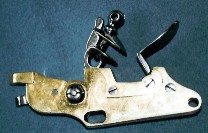
 $359 US
$359 US  $359 CAN
$359 CAN
CAN-001
Cannon Lock The first cannon lock was introduced in the Royal Navy in 1755. While a much more effective way to fire artillery, there was a learning curve to perfecting the technology. There were numerous patterns but all functioned in the same way: a flintlock attached to the vent area of the cannon that fired a blast of flame at the vent. Most used a cord system to trigger the lock's firing action.
By the 1790s a pattern was developed by Henry Nock that could be used on most artillery being used by both the Royal Navy and the Royal Artillery for siege artillery and the cannons of fortifications.
Because Nock was unable to meet supply demands, many of locks actually made for the British military (of a similar pattern) by SHERWOOD & Co. The lock offered here is a Sherwood lock.
The lock picture here is for 12 to 32 pounder cannons (Bloomfield pattern). A similar lock was used for Carronades but with a pointed bottom. There were two smaller locks for field artillery.
This item is very complex to manufacture and is of beautiful construction. This item is a must for anyone telling the story of artillery at this time period.